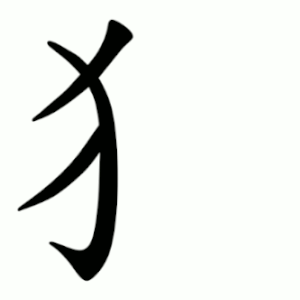犭
- the left radical form of 犬;
Usage in Korean
The radical form of the character 犬 (dog) includes the variant 犭, called the "dog-deer-radical" (개사슴록변).
There is also the full form 犬 itself used as a radical, called "dog radical" (개견부).
For example, the character 獄 (prison, 옥) contains both the dog radical 犭 and the enclosure radical (방). According to the Shuowen Jiezi (説文解字 shuōwén jiězì), there used to be a separate radical 㹜 (representing dogs barking), but later this was merged into the 犬 radical.
Characters that use the dog-deer radical 犭 or the dog radical 犬 often relate to animals, especially carnivores.
Examples include:
狗 (dog)
猫 (cat)
猯 (wildcat)
狼 (wolf)
狐 (fox)
獥 (wolf cub)
獸 (beast)
獵 (hunt)
獁 (a type of beast)
猶 (monkey/indeed)
猿 (ape)
and 獻 (offering), which depicts offering dog meat in a sacrificial context.
This radical is also used for characters expressing fierce or wild emotions, such as 狂 (mad),
獨 (alone)
猜 (jealous)
猖 (rampage)
獗 (rampage)
猝 (sudden)
猛 (fierce)
which relates both to animals and wild emotions.
Other characters using this radical include:
犯 (commit a crime)
狀 (form, shape)
獄 (prison)
獲 (obtain)
A modern criticism is that this radical is also used to denote other ethnic groups (such as 狄, meaning "barbarian"), which is viewed negatively today.
The name "dog-deer-radical" (개사슴록변) includes the term "deer" (록, 鹿) which is somewhat unrelated, causing some confusion. The reason is explained in Pyoamgo (표암고), written by the Joseon-era scholar Kang Se-hwang (강세황):
"People commonly write the deer radical 鹿 as the dog radical 犭. This is because the complex 鹿 was simplified to 犭 when writing characters such as 麒 and 麟. This simplification led to the mistaken assumption that all 鹿 radicals should be written as 犭. Similarly, other characters that take 犬 as a radical are also sometimes mixed up and referred to as 鹿 radicals."
In other words, since the 鹿 radical is complex, there was a custom to substitute it with 犭, originally the dog radical. Therefore, 犭 can be either the dog radical or a simplified form of the deer radical, leading to mixed naming. During this process, the original pronunciation "견" (dog) disappeared from the radical's name.
